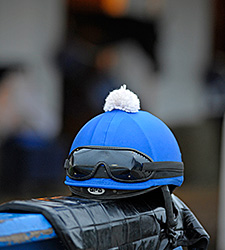Jockey Injury Database Calls for More Support

Organizers of the Jockey Injury Database said added participation will help generate needed statistical information to assist industry leaders in improving safety for jockeys in coming years.
During a presentation at the Welfare and Safety of the Racehorse Summit on Wednesday, July 9, at Keeneland, Dr. Carl Mattacola noted that most of the 369 injury reports that have been entered into the system were reported by riders or Jockeys' Guild representatives.
Mattacola, an assistant professor of athletic training at the University of Kentucky, is overseeing data collection and analysis of the Jockey Injury Database. He believes the vast majority of injuries suffered by jockeys in races are not being reported to the database and that greater participation from tracks will help close that gap.
"We obviously have an under-representation of the data," Mattacola said of the database launched in 2012.
Mattacola said riders have been cooperative, as they understand that such data can help improve their safety. But he said more tracks need to be involved and the consistency of data collection has to be improved.
"We realize you can't capture every bit of information, but we want to think of ways to better capture this information," Mattacola said.
The goal of the database is to consistently collect all of the relative information when a rider injury occurs in a race. Information being collected includes the nature of the injuries, where impact occurred (a rider hitting the ground, rail, or starting gate), where the injury occurred on the track, where in the race it occurred, and the equipment being used by the jockey.
Mattacola noted the efforts to reduce concussions and instances of heat stroke in other sports began with the collection of data. It's an effort similar to the industry's Equine Injury Database that collects information following horse injuries. More information is needed on rider injuries to help develop safer tracks, racing, and rider equipment.
Jockeys' Guild national manager Terry Meyocks said only a few tracks, including Keeneland, currently are participating in providing database reports. He said tracks owned by the Stronach Group also are beginning to participate.
"We'd like to see more support for this from throughout the industry," Meyocks said, noting that in the long run it will improve the sport for everyone.
Some reporting tracks could be added just through improved communication. California Horse Racing Board equine medical director Rick Arthur said a safety steward at each California track documents such rider injuries. Meyocks said that the currently collected information there was not being reported to the database, but he planned to talk with Arthur to find a way to make that a reality.
Matacola noted that the information is kept confidential. The database only is interested in documenting the numbers, not information on specific riders.
Early information generated by the database points to the biggest problem areas on the track in terms of rider injury being at the start of the race and in the stretch. Matacola said as more information is generated, more trends likely will emerge.
"One of our hopes is that this will become commonplace and grow it a lot bigger than this in the next two years," Mattacola said.
